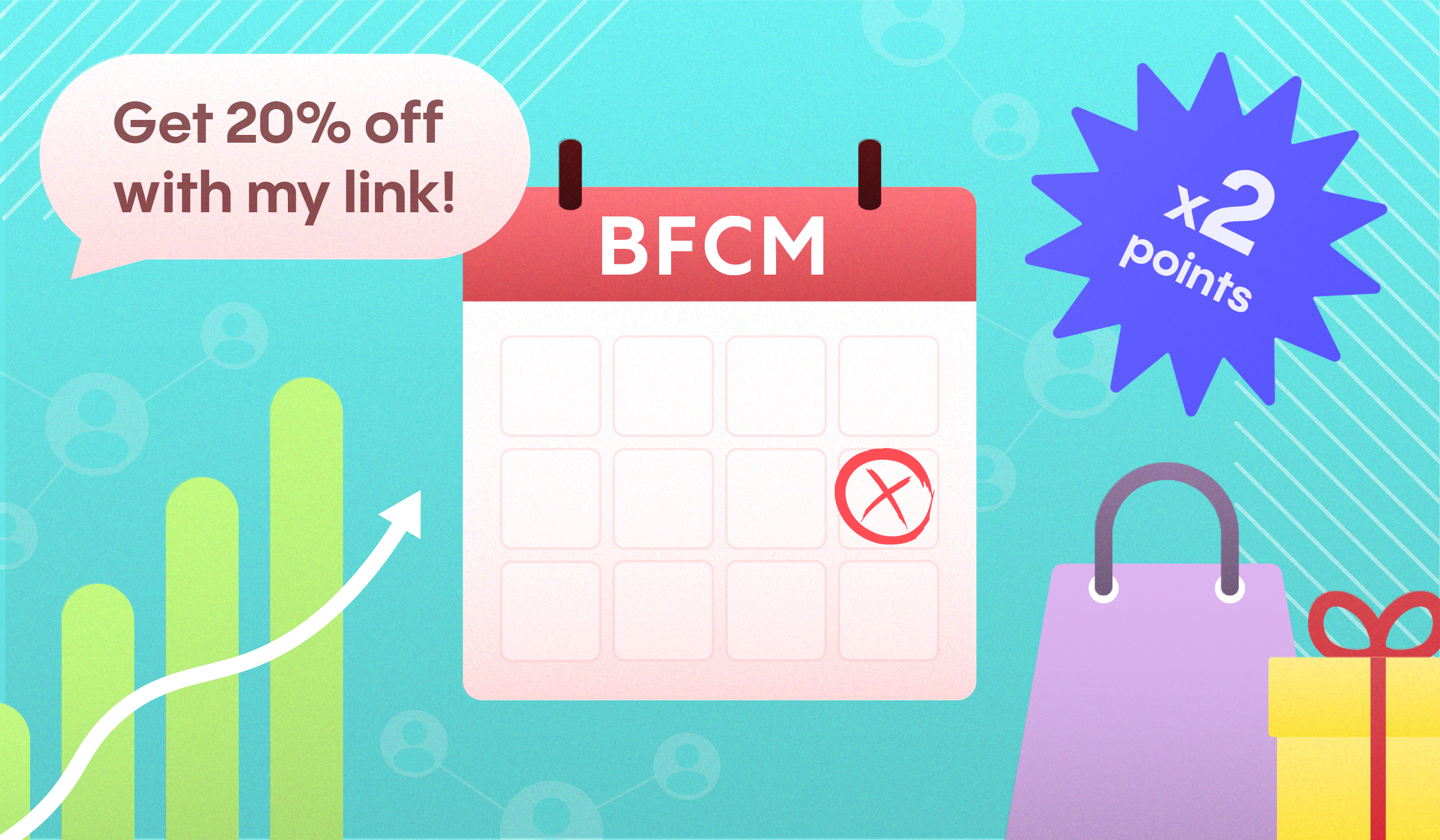No matter what a software as a service (SaaS) company offers to customers, whether it’s B2B- or B2C-focused, it’s easy to understand how one can benefit from a SaaS referral program.
Most SaaS platforms are inherently optimized to take advantage of word-of-mouth marketing programs due to a variety of factors. These include such advantages as:
- Existing customer SMS and/or email subscriber lists— Since most SaaS companies rely heavily on email and SMS marketing, these contact lists can easily be used to promote a SaaS referral program.
- Users (in most cases) frequently log into the platform — Every time a user logs back into a SaaS platform, it’s an opportunity to provide them with some form of reminder that a referral program offering valuable rewards is ready and waiting for them.
- SaaS products often serve specific niches or industries — Users within these unique communities tend to have strong connections with each other. Referral programs can tap into these networks, leveraging the tight-knit relationships and trust within the community to drive referrals and expand the user base.
- Regular product releases & updates: SaaS products often have unique features and benefits that users can genuinely advocate for, released at a regular drumbeat. Referral programs capitalize on this by incentivizing satisfied users to share their positive experiences with others in their network who might also benefit from the software.
- Subscription-based Revenue Model: Many SaaS companies operate on a subscription-based revenue model, where the goal is to retain customers over the long term. Referral programs can help in this regard by not only acquiring new customers but also encouraging existing ones to remain engaged and active, as they have a vested interest in seeing their referrals become long-term users.
Benefits of Referral Marketing for SaaS Companies
Some of the referral program benefits SaaS companies can expect from running a successful operationalized advocacy marketing effort include:
- Cost-Effective Customer Acquisition: Referral marketing leverages existing customers to bring in new business, reducing the need for expensive advertising and marketing campaigns.
- Increased Trust & Credibility: People are more likely to trust recommendations from friends, family, or colleagues. Referral marketing helps build trust and credibility for SaaS products since it comes recommended by someone the potential customer knows.
- Higher Quality Leads: Referrals often result in higher quality leads because they are coming from satisfied customers who understand the product and its benefits. These leads are more likely to convert into paying customers.
- Improved Customer Lifetime Value: Customers acquired through referrals tend to have higher lifetime value because they are more likely to be satisfied with the product and remain loyal over time.
- Faster Sales Cycle: Referrals can help shorten the sales cycle since prospects who come through referrals are already pre-qualified and have a higher level of trust in the product.
- Improved Customer Retention: Customers acquired through referrals are less likely to churn compared to those acquired through other channels. They already have a positive perception of the product, which can lead to higher retention rates.
- Enhanced Brand Awareness: Referral programs can help increase brand awareness as satisfied customers spread the word about your SaaS product to their networks, reaching potential customers who may not have been aware of your brand otherwise.
- Measurable ROI: Most SaaS companies are highly data-driven. Referral marketing campaigns can be tracked and measured, allowing SaaS companies to assess the effectiveness of their efforts and optimize their strategies for better results.
Key Steps for Creating a SaaS Referral Platform
Though every SaaS company will need to create a distinct customer rewards program that provides genuine value to their audience, many of the steps required to implement that program will remain the same across industry verticals:
- Establish clear and attainable goals for the program: Setting specific objectives helps to align the referral program with broader business objectives. For example, goals might include acquiring a certain number of new customers within a specified timeframe, increasing customer retention rates, or expanding into new market segments. By making these goals clear and achievable, the entire team can focus their efforts on driving the desired outcomes.
- Define your incentive strategy: Crafting the right incentives is crucial for motivating existing customers to refer others. This strategy involves deciding what type of rewards to offer, such as discounts, freebies, or credits, and determining the conditions for earning them. The incentives should be attractive enough to incentivize referrals but also aligned with the company's financial goals and sustainable over the long term.
- Chart out the ideal customer journeys: Mapping the customer journey helps identify the key touchpoints where referral opportunities naturally arise. By understanding how users interact with the product or service at each stage of the journey, you can pinpoint the most effective moments to encourage referrals. This ensures that the referral process feels seamless and integrated into the user experience, increasing the likelihood of participation.
- Create and deploy the program: Developing the referral program involves designing the referral process, creating referral links or codes, and implementing tracking mechanisms to monitor referrals. This step also includes setting up the necessary infrastructure, such as referral software or tracking systems, to ensure smooth execution of the program. Once everything is in place, the program can be launched to existing customers, inviting them to participate and start referring others.
- Promote and launch the program: Generating excitement and awareness around the referral program is essential for driving participation. This involves marketing the program through various channels, such as email campaigns, social media, and in-app notifications. The launch should highlight the benefits of participating in the program and make it easy for customers to get involved. By creating buzz around the launch, you can maximize initial engagement and encourage early adoption.
- Sustain awareness with ongoing marketing campaigns: Maintaining awareness of the referral program over time requires consistent marketing efforts. This could include regularly scheduled email updates, social media posts, or in-product messages reminding customers about the program and encouraging them to refer friends. By staying top-of-mind, you can ensure that the program continues to drive referrals and engagement among existing customers.
- Analyze and optimize performance: Continuous monitoring and analysis of program performance are essential for identifying areas of improvement and optimization. This involves tracking key metrics such as referral conversion rates, customer acquisition costs, and ROI to assess the effectiveness of the program. By identifying trends and patterns in the data, you can make informed decisions about how to refine the program and maximize its impact.
- Iterate and refine the program: Based on the insights gained from performance analysis, the referral program should be continually refined and optimized. This could involve making adjustments to the incentive structure, streamlining the referral process, or testing different messaging strategies to improve results. By iterating on the program over time, you can ensure that it remains relevant and effective in driving referrals and achieving your goals.
- Encourage effective sharing by advocates: Empowering advocates to share their referral links or codes effectively is key to maximizing the reach of the program. This could involve providing them with resources such as pre-written messages, social media graphics, or email templates to make it easier for them to spread the word. By equipping advocates with the tools they need, you can amplify the impact of their referrals and drive greater participation in the program.
- Enhance conversion rates of referred friends: Optimizing the conversion process for referred friends ensures that the referral program not only generates leads but also converts them into paying customers. This might involve streamlining the signup process, providing personalized onboarding experiences, or offering incentives to referred friends to incentivize them to take action. By removing barriers to conversion, you can increase the likelihood that referred leads will become loyal customers.
- Experiment with A/B testing: A/B testing allows you to experiment with different elements of the referral program to identify what resonates best with users. This could include testing different incentive structures, referral messaging, or referral placement within the user journey. By systematically testing variations and measuring their impact, you can refine the program and optimize its performance over time.
- Segment users for targeted marketing: Segmenting users based on behavior, demographics, or other criteria enables more targeted marketing efforts and personalized referral experiences. By tailoring incentives and messaging to specific segments, you can increase the relevance and effectiveness of the referral program for different user groups. This ensures that each segment receives a customized experience that speaks to their unique needs and preferences.
- Learn from successful programs and test new ideas: Studying successful referral programs in the industry and experimenting with different campaign concepts can provide valuable insights and inspiration for optimizing your own program. By staying informed about industry trends and competitor strategies, you can identify opportunities to innovate and differentiate your program. Testing new ideas allows you to stay ahead of the curve and continuously improve the program's performance.
- Expand into new customer bases with alternative program types: As the referral program matures, exploring alternative program types such as sweepstakes or influencer partnerships can help reach new audiences and drive further growth. These alternative approaches can complement the existing referral program and open up new opportunities for customer acquisition. By diversifying your approach, you can tap into additional customer bases and maximize the program's impact.
Conclusion
SaaS companies can greatly benefit from an effective and concerted referral marketing program. And the most effective way to ensure a word-of-mouth marketing program’s success is to engage an experienced team of referral marketing experts, like the team at Friendbuy.
Friendbuy’s platform provides SaaS brands with access to a variety of critical referral marketing features that enable you to track referral marketing stats, prevent fraud, integrate with email and SMS marketing software, and design every aspect of your program down to the shape of the CTA buttons.
To learn more about how to create a revenue-driving SaaS referral marketing program, contact Friendbuy’s team today!









.avif)

